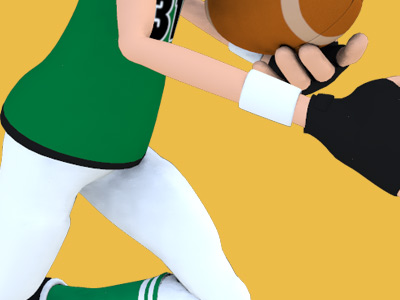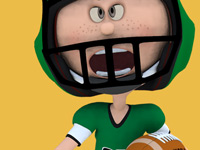American football

Air Coryell (American Football Strategy)
In American football, Air Coryell is the offensive scheme and philosophy developed by former San Diego Chargers coach Don Coryell. The offensive philosophy has been also called the "Coryell offense" or the "vertical offense".
With Dan Fouts as quarterback, the San Diego Chargers' offense was among the greatest passing offenses in National Football League history. The Chargers led the league in passing yards an NFL record six consecutive years from 1978 to 1983 and again in 1985. They also led the league in total yards in offense 1978–83 and 1985. Dan Fouts, Charlie Joiner, and Kellen Winslow would all be inducted into the Pro Football Hall of Fame from those Charger teams.
Pre-Coryell NFL
The pro set was the default NFL scheme prior to Don Coryell. While it is more of a formation, the underlying philosophy of the pro set was based on becoming more successful when a team was forced to pass by providing 1 or even 2 backs to help protect the QB. Prior to Coryell, the pro set was generally a running offense that used play action fakes to set up deep passing attempts when defenses stacked up vs the running game.
The pro set features a TE, 2 WRs, and a Halfback and fullback, often split behind the QB. While QBs can take a snap from the center from the shotgun position, in general the pro set QB takes the ball under center to allow for better play action fakes to the running back. Offenses tended to be ball-control, grind-it-out style offenses. In 1978, the contact from defenders on receivers was minimized with the passing of Mel Blount Rule.
Coryell opens up passing in the NFL
Coryell set the league on its ear with his passing offenses after moving up from the college ranks. He won two consecutive division titles (1974–1975) with the St. Louis Cardinals. The Cardinals offense emphasized the pass while running the standard pro set. Coryell moved to the Chargers and won three straight division titles (1979–1981) and reached the playoffs in four consecutive seasons. The Chargers in 1979 were the first AFC Western Division champion to run more passing plays (541) than rushing (481). Coryell's Chargers teams led the league in passing in seven of eight years. The Pro Football Hall of Fame called the Chargers' offenses under Coryell "one of the most explosive and exciting offenses that ever set foot on an NFL field." Coryell is the first coach ever to win more than 100 games at both the collegiate and professional level. Coryell's offensive innovations changed the entire nature of the league from a run-first league to a pass-first one.
Today most NFL offenses' passing games are at least partially based on Coryell conventions.
Former coach of the St. Louis Rams, Mike Martz, says "Don is the father of the modern passing game. People talk about the West Coast offense, but Don started the 'West Coast' decades ago and kept updating it. You look around the NFL now, and so many teams are running a version of the Coryell offense. Coaches have added their own touches, but it's still Coryell's offense. He has disciples all over the league. He changed the game."
Attributes of Air Coryell
The Coryell offense is based on Sid Gillman's offense that required the defense to defend the entire field. The passing game was based on timing and rhythm, and coaching the system required a lot of repetition. Coryell expanded on those principles by putting receivers in motion. With the new defensive rules limiting contact to near the line of scrimmage, receivers in motion would be virtually impossible to jam. Coryell not only placed wide receivers in motion, he did so with tight ends and running backs as well. Putting the players in motion also had the advantage of allowing the quarterback to determine pre-snap if the defense would be playing zone or man-to-man defense. It was easier to read the coverage before the snap than afterwards due to the pass rush. It is also harder for a defender to cover if he has to change direction with the receiver instead of squaring up and getting set before a play. Defenses that react to the motion could get confused, leaving a defender in the wrong position.
The offense did not have any set formations, as receivers could line up anywhere on any given pass play. Passes were thrown to a spot before the receiver even got there, allowing defenders no hint where the pass was being targeted. Each receiver had two or three different route options they could adjust depending on the coverage during the play. Throwing a deep pass was the first option on each play. Coryell's offense had more progressions than Gillman's, with backup options for screen passes and underneath routes.
The Coryell offense is a combination of deep and mid range passing and power running. The offense relies on getting all five receivers out into patterns that combined stretched the field, setting up defensive backs with route technique and the Quarterback throwing to a spot on time where the receiver can catch and turn upfield. Pass protection is critical to success because at least two of the five receivers will run a deep in, skinny post, comeback, speed out, or shallow cross.
Overall the goal of the Coryell offense is to have at least two downfield, fast wide receivers who adjust to the deep pass very well, combined with a sturdy pocket quarterback with a strong arm. The Coryell offense uses three key weapons. The first is a strong inside running game, the second is its ability to strike deep with two or more receivers on any play, and the third is to not only use those two attacks in cooperation with each other, but to include a great deal of mid-range passing to a TE, WR, or back.
The Coryell offense introduced the concept of a tight end that ran wide receiver-type routes with Kellen Winslow in 1980. Tight ends previously were primarily blockers lined up next to an offensive lineman and ran short to medium drag routes. Winslow was put in motion so he would not be jammed at the line, or he was lined up wide or in the slot against a smaller cornerback. Former Chargers assistant coach Al Saunders said Winslow was "a wide receiver in an offensive lineman's body." Back then, defenses would cover Winslow with a strong safety or a linebacker, as zone defenses were not as popular. Strong safeties in those times were almost like another linebacker, a run defender who could not cover a tight end as fast as Winslow. Providing another defender to help the strong safety opened up other holes. Former head coach Jon Gruden called Winslow the first "joker" in the NFL. He could line up unpredictably in any formation from a three-point stance as a blocker to a two-point stance or being in motion as a receiver.
After the Chargers in 1980 acquired running back Chuck Muncie, the offense started using a single set back featuring Muncie as the lone running back and adding a second tight end into the game. When defenses countered with extra defensive backs, the offense would run the ball. Joe Gibbs, the Hall of Fame coach and then-Chargers offensive coordinator, said that marked "the evolution of the one-back offense."
Gibbs won three Super Bowls with a Coryell offense featuring a smash mouth running game with 3 different running backs, Hall of Famer John Riggins, George Rogers and Earnest Byner behind a massive offensive line known as the "Hogs" and a 3 receiver deep air attack featuring Hall of Famer Art Monk, Gary Clark and Ricky Sanders, known as "The Posse." Gibbs usually kept the tight end in as an extra blocker, especially to neutralize pass rushing specialist and Hall of Fame linebacker Lawrence Taylor of the New York Giants. Today, many Coryell offenses still reduce the use a tight end, except in the red zone. Gibbs is also the first head coach in NFL history to win 3 Super Bowls with 3 different quarterbacks: Joe Theismann, Doug Williams, and Mark Rypien.
Norv Turner, former San Diego Chargers head coach and former offensive coordinator of the San Francisco 49ers and Dallas Cowboys, also implemented a version of the Coryell style of offense. The Turner strain of Coryell offenses are still very reliant on a good receiving TE. Norv Turner strains sometimes feature an 'F-Back' (formerly known as an 'H-Back' in the 1980s), a hybrid tight end/wide receiver/fullback/running back. An F-Back is a multi-purpose, unpredictable tool for the offense. On any play he may carry the ball, lead block or pass block, play as a wide receiver, or run a tight end route. He is also part decoy, as his unpredictable role forces defenses to keep an eye on him, thereby opening up other opportunities for the offense.
SPORTS



American Football
Game play in American football consists of a series of downs, individual plays of short duration, outside of which the ball is dead or not in play. These can be plays from scrimmage – passes, runs, punts, or field goal attempts (from either a place kick or a drop kick) – or free kicks such as kickoffs and fair catch kicks. Substitutions can be made between downs, which allows for a great deal of specialization as coaches choose the players best suited for each particular situation. During a play, each team should have no more than 11 players on the field, and each of them has specific tasks assigned for that specific play.
Rules and gameplay
- Scoring
- Maneuvers
- Strategy
- Play types
- Penalties
- Turnovers
- Downs
- Teams and positions
- Field
- Equipment
- Duration and time stoppages
- Advancing the ball and downs
- Kicking
- Officials and fouls
Positions
Offensive (Interior) line
Backs and receivers
Defensive line
Linebackers
Defensive backs
Special teams
- Kicker (K)
- Holder (H)
- Long snapper (LS)
- Punter (P)
- Kickoff specialist (KOS)
- Kick returner (KR) and Punt returner (PR)
- Upback
- Gunner
- Jammer


RESOURCES
This article uses material from the Wikipedia articles "American football", "American football rules", "Strategy", "Air Coryell", which is released under the Creative Commons Attribution-Share-Alike License 3.0.
© Stories Preschool. All Rights Reserved.





